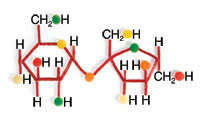Unlocking the Chemical Power of Sugar
By Capterton Gillett
 Sucrose (above), the addictive substance better known as table sugar, is built from the simple sugars glucose and fructose. More complex forms of sugar may be useful in the fight against cancer.When Pengfei Wang, Ph.D., looks at sugar, he doesn’t think about sweetening his coffee. The UAB organic chemist sees a powerful molecule that can unlock the secrets of bacteria and human proteins and may one day even offer a cure for cancer.
Sucrose (above), the addictive substance better known as table sugar, is built from the simple sugars glucose and fructose. More complex forms of sugar may be useful in the fight against cancer.When Pengfei Wang, Ph.D., looks at sugar, he doesn’t think about sweetening his coffee. The UAB organic chemist sees a powerful molecule that can unlock the secrets of bacteria and human proteins and may one day even offer a cure for cancer.
“In the scientific community these days, people think that sugar can play a much more important role—it’s not just an energy storage molecule,” Wang says. More than 50 percent of the proteins in the human body are coated with different kinds of sugar molecules, Wang explains, and “you can find them on most bacterial cell surfaces.” That makes these molecules a target for cellular invaders and defenders alike.
The sugars coating the surfaces of cells are not the kind that make cookies taste delicious. Instead, they are elaborate constructions built from the most basic of sugar units: monosaccharides. Combine the monosaccharides glucose and fructose, for instance, and you create the disaccharide sucrose, or common table sugar. Take ribose and deoxyribose, two forms of a complex sugar called pentose, and you have a significant part of the RNA and DNA that define life as we know it. “Different sugar molecules—different building blocks—can be connected in different ways,” Wang says. “That generates so many structurally different molecules, and they have many different biological functions.”
Sugar Fight
Sugar ShutdownWhat about sugar’s mystical powers to destroy a car engine? Mythical, says UAB chemist Pengfei Wang, Ph.D. Researchers at the University of California, Berkeley determined in 1994 that sugar does not dissolve in gasoline, and any ensuing sugar sludge could be cleaned up with a fresh fuel filter and, in a worst-case scenario, a good engine flush. |
In its more complex forms, sugar takes on a number of roles, including immune function. “The human immune system can identify the different sugar molecules on the surface of bacterial cells” and mount an attack in response, Wang says. Certain sugars can even take the offensive: Red microalgal polysaccharides have been found to inhibit the growth of certain viruses.
Sugar may even hold cancer-fighting potential. Researchers have used a complex sugar polymer known as hyaluronan to resensitize breast cancer tissue that has become resistant to chemotherapy agents. Mannose, a polysaccharide found in cranberries, has been found to inhibit tumor growth and communication between cancer cells, along with its more well-known ability to help block urinary tract infections.
“Also, researchers are finding on the surface of different cancer cells a population of sugars that are different from those on normal cells,” says Wang. Now they are working to develop agents that can seek out these sugars and selectively target the cancer cells for destruction. Sweet revenge, indeed.